Chris Eboch's Blog, page 13
November 14, 2018
Turning an Idea into Story: Building the Middle #writing #NaNoWriMo
The middle of a story is a trouble spot for many writers. Maybe it feels slow, maybe it feels boring, maybe you can't even figure out what happens next.
A good middle should be filled with complications.
If a character solves his problem or reaches his goal easily, the story is boring. To keep tension high, you need complications. For short stories, try the “rule of three” and have the main character try to solve the problem three times. The first two times, he fails and the situation worsens.
Remember: the situation should worsen. If things stay the same, he still has a problem, but the tension is flat. If his first attempts make things worse, tension rises.
 For novels, you may have even more attempts and failures. In my first Haunted book, The Ghost on the Stairs, I made sure each ghost encounter felt more dangerous. As Tania tries to get closer to the ghost in order to help her, Jon worries that she will go too far and be injured or even killed. With enough variety, you can sustain this kind of tension indefinitely (witness the ongoing battle between Harry and Voldemort in the seven-book Harry Potter series).
For novels, you may have even more attempts and failures. In my first Haunted book, The Ghost on the Stairs, I made sure each ghost encounter felt more dangerous. As Tania tries to get closer to the ghost in order to help her, Jon worries that she will go too far and be injured or even killed. With enough variety, you can sustain this kind of tension indefinitely (witness the ongoing battle between Harry and Voldemort in the seven-book Harry Potter series).
Worse and Worser
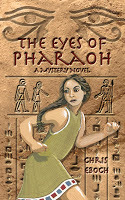 You can worsen the situation in several ways. The main character’s actions could make the challenge more difficult. In my children’s mystery set in ancient Egypt, The Eyes of Pharaoh, a young temple dancer searches for her missing friend. But when she asks questions at the barracks where he was a soldier, she attracts dangerous attention from his enemies.
You can worsen the situation in several ways. The main character’s actions could make the challenge more difficult. In my children’s mystery set in ancient Egypt, The Eyes of Pharaoh, a young temple dancer searches for her missing friend. But when she asks questions at the barracks where he was a soldier, she attracts dangerous attention from his enemies.
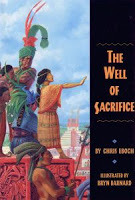 The villain may also raise the stakes. In my Mayan historical drama, The Well of Sacrifice, the main character escapes a power-hungry high priest. He threatens to kill her entire family, forcing her to return to captivity.
The villain may also raise the stakes. In my Mayan historical drama, The Well of Sacrifice, the main character escapes a power-hungry high priest. He threatens to kill her entire family, forcing her to return to captivity.
Secondary characters can cause complications, too, even if they are not “bad guys.” In The Ghost on the Stairs, the kids’ mother decides to spend the day with them, forcing them to come up with creative ways to investigate the ghost while under her watchful eyes.
Finally, the main character may simply run out of time. At her first attempt, she had a week. At her second attempt, she had a day. Those two attempts have failed, and now she has only an hour! That creates tension.
• For each turning point in the story, brainstorm 10 things that could happen next. Then pick the one that is the worst or most unexpected, so long as it is still believable for the story.
See the "middles" tab to the right for more advice on building an exciting and dramatic middle.
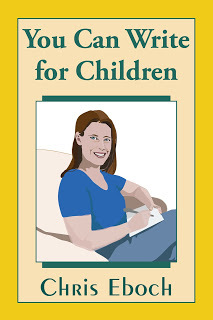 Chris Eboch is the author of over 60 books for children, including nonfiction and fiction, early reader through teen. Her novels for ages nine and up include The Eyes of Pharaoh, a mystery in ancient Egypt; The Well of Sacrifice, a Mayan adventure; The Genie’s Gift, a middle eastern fantasy; and the Haunted series, about kids who travel with a ghost hunter TV show, which starts with The Ghost on the Stairs.
Chris Eboch is the author of over 60 books for children, including nonfiction and fiction, early reader through teen. Her novels for ages nine and up include The Eyes of Pharaoh, a mystery in ancient Egypt; The Well of Sacrifice, a Mayan adventure; The Genie’s Gift, a middle eastern fantasy; and the Haunted series, about kids who travel with a ghost hunter TV show, which starts with The Ghost on the Stairs.
Her writing craft books include Advanced Plotting and You Can Write for Children: How to Write Great Stories, Articles, and Books for Kids and Teenagers. You Can Write for Children : How to Write Great Stories, Articles, and Books for Kids and Teenagers is available for the Kindle, in paperback, or in Large Print paperback. Advanced Plotting is available from Amazon(paperback or Kindle, free in KU) or Barnes & Noble (paperback).
Learn more at www.chriseboch.comor her Amazon page.
A good middle should be filled with complications.
If a character solves his problem or reaches his goal easily, the story is boring. To keep tension high, you need complications. For short stories, try the “rule of three” and have the main character try to solve the problem three times. The first two times, he fails and the situation worsens.
Remember: the situation should worsen. If things stay the same, he still has a problem, but the tension is flat. If his first attempts make things worse, tension rises.
 For novels, you may have even more attempts and failures. In my first Haunted book, The Ghost on the Stairs, I made sure each ghost encounter felt more dangerous. As Tania tries to get closer to the ghost in order to help her, Jon worries that she will go too far and be injured or even killed. With enough variety, you can sustain this kind of tension indefinitely (witness the ongoing battle between Harry and Voldemort in the seven-book Harry Potter series).
For novels, you may have even more attempts and failures. In my first Haunted book, The Ghost on the Stairs, I made sure each ghost encounter felt more dangerous. As Tania tries to get closer to the ghost in order to help her, Jon worries that she will go too far and be injured or even killed. With enough variety, you can sustain this kind of tension indefinitely (witness the ongoing battle between Harry and Voldemort in the seven-book Harry Potter series).Worse and Worser
 You can worsen the situation in several ways. The main character’s actions could make the challenge more difficult. In my children’s mystery set in ancient Egypt, The Eyes of Pharaoh, a young temple dancer searches for her missing friend. But when she asks questions at the barracks where he was a soldier, she attracts dangerous attention from his enemies.
You can worsen the situation in several ways. The main character’s actions could make the challenge more difficult. In my children’s mystery set in ancient Egypt, The Eyes of Pharaoh, a young temple dancer searches for her missing friend. But when she asks questions at the barracks where he was a soldier, she attracts dangerous attention from his enemies. The villain may also raise the stakes. In my Mayan historical drama, The Well of Sacrifice, the main character escapes a power-hungry high priest. He threatens to kill her entire family, forcing her to return to captivity.
The villain may also raise the stakes. In my Mayan historical drama, The Well of Sacrifice, the main character escapes a power-hungry high priest. He threatens to kill her entire family, forcing her to return to captivity.Secondary characters can cause complications, too, even if they are not “bad guys.” In The Ghost on the Stairs, the kids’ mother decides to spend the day with them, forcing them to come up with creative ways to investigate the ghost while under her watchful eyes.
Finally, the main character may simply run out of time. At her first attempt, she had a week. At her second attempt, she had a day. Those two attempts have failed, and now she has only an hour! That creates tension.
• For each turning point in the story, brainstorm 10 things that could happen next. Then pick the one that is the worst or most unexpected, so long as it is still believable for the story.
See the "middles" tab to the right for more advice on building an exciting and dramatic middle.
 Chris Eboch is the author of over 60 books for children, including nonfiction and fiction, early reader through teen. Her novels for ages nine and up include The Eyes of Pharaoh, a mystery in ancient Egypt; The Well of Sacrifice, a Mayan adventure; The Genie’s Gift, a middle eastern fantasy; and the Haunted series, about kids who travel with a ghost hunter TV show, which starts with The Ghost on the Stairs.
Chris Eboch is the author of over 60 books for children, including nonfiction and fiction, early reader through teen. Her novels for ages nine and up include The Eyes of Pharaoh, a mystery in ancient Egypt; The Well of Sacrifice, a Mayan adventure; The Genie’s Gift, a middle eastern fantasy; and the Haunted series, about kids who travel with a ghost hunter TV show, which starts with The Ghost on the Stairs. Her writing craft books include Advanced Plotting and You Can Write for Children: How to Write Great Stories, Articles, and Books for Kids and Teenagers. You Can Write for Children : How to Write Great Stories, Articles, and Books for Kids and Teenagers is available for the Kindle, in paperback, or in Large Print paperback. Advanced Plotting is available from Amazon(paperback or Kindle, free in KU) or Barnes & Noble (paperback).
Learn more at www.chriseboch.comor her Amazon page.
Published on November 14, 2018 04:00
October 8, 2018
Get ready for #Halloween with #ghost stories that share #history!
“Haunted is a fun read with some thrills and chills and has the added bonus of some genuine, compassionate personalities.” - School Library Journal
“I LOVED this book. My daughter who is 11 could not put this book down. She read it so quickly and is asking for more!”

In my Haunted series, thirteen-year-old Jon and his eleven-year-old sister, Tania, are typical modern kids – except for the fact that Tania can communicate with ghosts.
In The Ghost on the Stairs, the kids help investigate a hundred-year-old tragedy in Colorado silver mining country. The Riverboat Phantom puts them on the Mississippi River on an antique riverboat. For The Ghost Miner’s Treasure, Jon and Tania travel to the Superstition Mountains of Arizona, where the ghost of an old miner is still looking for his lost mine.
In this series, the ghosts are being held in this world by something that happened in the past. In order to help free the ghosts, Jon and Tania must understand that past.
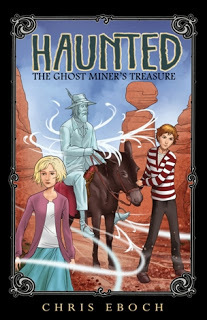 “My 10 year old daughter HATES to read. These books kept her interested and wanting to read more. I downloaded all 4 in this series. THANK YOU!!”
“My 10 year old daughter HATES to read. These books kept her interested and wanting to read more. I downloaded all 4 in this series. THANK YOU!!”
“What I loved most of all, was the way my 4th grade daughter got sucked into the story. She's a reluctant reader so it was a joy to see her completely absorbed in a book; she immediately started the second book in the series when she finished, and can't wait for more.” – Amazon readers
Get all four books in the series from Amazon, Barnes & Noble, or other retailers.
For writing advice that came from writing these books, see:
How Do You Turn Your Idea into a Story?Developing Your Story for Children or Teenagers
Turning an Idea into a Story: Making Muscular Action!
Market Research: Personal Connections
The Drama of a Place
Paragraphing for Cliffhangers
See also my post on Learning #History through Ghost Stories for using books such as these in the classroom.
HAUNTED
Thirteen-year-old Jon and his eleven-year-old sister, Tania, are typical kids – except for the fact that Tania can communicate with ghosts. Their mom and stepdad are producers of a ghost-hunter reality television show, but they don’t know about Tania’s gift, and Tania wants to keep it that way.
Jon can't see ghosts and didn't believe in them, but things are getting too crazy for any other explanation. And if softhearted Tania wants to help the ghosts, Jon will have to protect her and try to keep them both out of trouble.
First the siblings have to find out what happened to keep each ghost trapped in this world. Then they need to help the ghosts move on—sometimes by letting them take over Tania’s body. All this while dealing with their overprotective mother, a stepfather who’d want to exploit Tania’s gift, and a changing assortment of human troublemakers.
Life gets interesting when your sister sees ghosts. And the TV show’s shooting season is just beginning....
 Chris Eboch is the author of over 60 books for children, including nonfiction and fiction, early reader through teen. Her novels for ages nine and up include The Eyes of Pharaoh, a mystery in ancient Egypt; The Well of Sacrifice, a Mayan adventure; The Genie’s Gift, a middle eastern fantasy; and the Haunted series, about kids who travel with a ghost hunter TV show, which starts with The Ghost on the Stairs. Her writing craft books include You Can Write for Children: How to Write Great Stories, Articles, and Books for Kids and Teenagers, and Advanced Plotting.
Chris Eboch is the author of over 60 books for children, including nonfiction and fiction, early reader through teen. Her novels for ages nine and up include The Eyes of Pharaoh, a mystery in ancient Egypt; The Well of Sacrifice, a Mayan adventure; The Genie’s Gift, a middle eastern fantasy; and the Haunted series, about kids who travel with a ghost hunter TV show, which starts with The Ghost on the Stairs. Her writing craft books include You Can Write for Children: How to Write Great Stories, Articles, and Books for Kids and Teenagers, and Advanced Plotting.
Learn more at https://chriseboch.com/ or her Amazon page, or check out her writing tips at her Write Like a Pro! blog.
“I LOVED this book. My daughter who is 11 could not put this book down. She read it so quickly and is asking for more!”

In my Haunted series, thirteen-year-old Jon and his eleven-year-old sister, Tania, are typical modern kids – except for the fact that Tania can communicate with ghosts.
In The Ghost on the Stairs, the kids help investigate a hundred-year-old tragedy in Colorado silver mining country. The Riverboat Phantom puts them on the Mississippi River on an antique riverboat. For The Ghost Miner’s Treasure, Jon and Tania travel to the Superstition Mountains of Arizona, where the ghost of an old miner is still looking for his lost mine.
In this series, the ghosts are being held in this world by something that happened in the past. In order to help free the ghosts, Jon and Tania must understand that past.
 “My 10 year old daughter HATES to read. These books kept her interested and wanting to read more. I downloaded all 4 in this series. THANK YOU!!”
“My 10 year old daughter HATES to read. These books kept her interested and wanting to read more. I downloaded all 4 in this series. THANK YOU!!” “What I loved most of all, was the way my 4th grade daughter got sucked into the story. She's a reluctant reader so it was a joy to see her completely absorbed in a book; she immediately started the second book in the series when she finished, and can't wait for more.” – Amazon readers
Get all four books in the series from Amazon, Barnes & Noble, or other retailers.
For writing advice that came from writing these books, see:
How Do You Turn Your Idea into a Story?Developing Your Story for Children or Teenagers
Turning an Idea into a Story: Making Muscular Action!
Market Research: Personal Connections
The Drama of a Place
Paragraphing for Cliffhangers
See also my post on Learning #History through Ghost Stories for using books such as these in the classroom.
HAUNTED
Thirteen-year-old Jon and his eleven-year-old sister, Tania, are typical kids – except for the fact that Tania can communicate with ghosts. Their mom and stepdad are producers of a ghost-hunter reality television show, but they don’t know about Tania’s gift, and Tania wants to keep it that way.
Jon can't see ghosts and didn't believe in them, but things are getting too crazy for any other explanation. And if softhearted Tania wants to help the ghosts, Jon will have to protect her and try to keep them both out of trouble.
First the siblings have to find out what happened to keep each ghost trapped in this world. Then they need to help the ghosts move on—sometimes by letting them take over Tania’s body. All this while dealing with their overprotective mother, a stepfather who’d want to exploit Tania’s gift, and a changing assortment of human troublemakers.
Life gets interesting when your sister sees ghosts. And the TV show’s shooting season is just beginning....
 Chris Eboch is the author of over 60 books for children, including nonfiction and fiction, early reader through teen. Her novels for ages nine and up include The Eyes of Pharaoh, a mystery in ancient Egypt; The Well of Sacrifice, a Mayan adventure; The Genie’s Gift, a middle eastern fantasy; and the Haunted series, about kids who travel with a ghost hunter TV show, which starts with The Ghost on the Stairs. Her writing craft books include You Can Write for Children: How to Write Great Stories, Articles, and Books for Kids and Teenagers, and Advanced Plotting.
Chris Eboch is the author of over 60 books for children, including nonfiction and fiction, early reader through teen. Her novels for ages nine and up include The Eyes of Pharaoh, a mystery in ancient Egypt; The Well of Sacrifice, a Mayan adventure; The Genie’s Gift, a middle eastern fantasy; and the Haunted series, about kids who travel with a ghost hunter TV show, which starts with The Ghost on the Stairs. Her writing craft books include You Can Write for Children: How to Write Great Stories, Articles, and Books for Kids and Teenagers, and Advanced Plotting.Learn more at https://chriseboch.com/ or her Amazon page, or check out her writing tips at her Write Like a Pro! blog.
Published on October 08, 2018 02:00
September 17, 2018
Nonfiction Truths: Finding Your Theme in Nonfiction
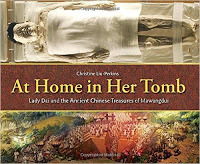 Writers tend to talk about theme less than they talk about characters, plot, and even setting. When theme does come up, it's usually with fiction. Yet identifying a theme can even help in writing powerful nonfiction.
Writers tend to talk about theme less than they talk about characters, plot, and even setting. When theme does come up, it's usually with fiction. Yet identifying a theme can even help in writing powerful nonfiction. Christine Liu-Perkins, author of At Home in Her Tomb: Lady Dai and the Ancient Chinese Treasures of Mawangdui, says, “My book is about a set of 2,100-year-old tombs in China that had over 3,000 well-preserved artifacts, including the body of a woman. I decided to write about the tombs as a time capsule, the various artifacts revealing what life was like during that period. Coming up with a theme really helped me develop the focus and content for my nonfiction book, and also helped in pitching my proposal to the publisher.”
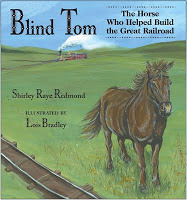 Shirley Raye Redmond gives another example. “Before writing my first draft of
Blind Tom: The Horse Who Helped Build theGreat Railroad
(Mountain Press Publishing), I narrowed the focus of my story and identified my story theme by answering the following questions as thoroughly as possible: who, what, when, where, how and why? I then abbreviated my answers so they fit concisely on an index card. On the back of the card, I wrote my theme statement: With perseverance, ordinary people (and even a blind horse) can play important roles in shaping major historical events. I kept my ‘focus card’ where I could see it as I drafted—and later refined—my story.”
Shirley Raye Redmond gives another example. “Before writing my first draft of
Blind Tom: The Horse Who Helped Build theGreat Railroad
(Mountain Press Publishing), I narrowed the focus of my story and identified my story theme by answering the following questions as thoroughly as possible: who, what, when, where, how and why? I then abbreviated my answers so they fit concisely on an index card. On the back of the card, I wrote my theme statement: With perseverance, ordinary people (and even a blind horse) can play important roles in shaping major historical events. I kept my ‘focus card’ where I could see it as I drafted—and later refined—my story.”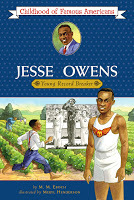 For my fictionalized biography of Olympic runner Jesse Owens, I considered the various lessons of his life in order to focus the book. Because he overcame ill health, racism, poverty and a poor education to become one of the greatest athletes the world has known, a theme quickly presented itself: Suffering can make you stronger, if you face it with courage and determination.
For my fictionalized biography of Olympic runner Jesse Owens, I considered the various lessons of his life in order to focus the book. Because he overcame ill health, racism, poverty and a poor education to become one of the greatest athletes the world has known, a theme quickly presented itself: Suffering can make you stronger, if you face it with courage and determination. With this in mind, I chose to open the book when Jesse was five, and his mother cut a growth from his chest with a knife. I ended the chapter with his father saying, “If he survived that pain, he’ll survive anything life has to offer. Pain won’t mean nothing to him now.” Jesse shows that spirit again and again throughout Jesse Owens: Young Record Breaker (Simon & Schuster), written under the name M. M. Eboch. Identifying that theme helped me craft a dramatic story, and may even inspire kids to tackle their greatest challenges.
In your theme, you can find the heart of your story. It’s your chance to share what you believe about the world, so take the time to identify and clarify your theme, and make sure your story supports it. Through your messages, you may influence children, and perhaps even change lives.
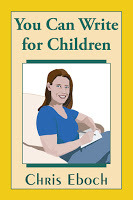 Chris Eboch is the author of
You Can Write for Children
: A Guide to Writing Great Stories, Articles, and Books for Kids and Teenagers. Order for Kindle, in paperback, or in Large Print paperback. She is also the author of Advanced Plotting.
Chris Eboch is the author of
You Can Write for Children
: A Guide to Writing Great Stories, Articles, and Books for Kids and Teenagers. Order for Kindle, in paperback, or in Large Print paperback. She is also the author of Advanced Plotting.Chris has published over 50 books for children, including nonfiction and fiction, early reader through teen. Her novels for ages nine and up include The Eyes of Pharaoh, a mystery in ancient Egypt; The Well of Sacrifice, a Mayan adventure; The Genie’s Gift, a middle eastern fantasy; and the Haunted series, about kids who travel with a ghost hunter TV show, which starts with The Ghost on the Stairs. Her writing craft books include You Can Write for Children: How to Write Great Stories, Articles, and Books for Kids and Teenagers, and Advanced Plotting.
Learn more at https://chriseboch.com/or her Amazon page.
Published on September 17, 2018 05:13
September 12, 2018
Shut Up & Write: Julie Howard on Finding a #Writing Community
 Writing doesn’t have to be a lonely business
Writing doesn’t have to be a lonely businessYou’d think my laptop is my best friend. We go to coffee shops together, it rides next to me in my car, and I spend hours alone with it. When it’s feeling rundown, I’m the one it relies on to plug it in and lift its energy. Right now, we’re on vacation in Canada and spending a week in a mountain chalet with a tremendous view of the Selkirk MountainsTo be a writer, you have to write. That means you’re alone much of the time and, for me, focused on an imaginary world. This is a recipe for cutting oneself off from reality and real relationships. It shouldn’t be surprising loneliness creeps in. Several years ago, I found a great solution that not only solves the issue of human contact, but also significantly inspires my writing.
At first, I did what a lot of writers do. I went to coffee shops. There, at least, the voices and clatter of humans surrounded me. A few customers found their way into my stories – whether through their voice tones or hair color or the shape of their nose. A snippet of conversation became the inspiration for a side plot. I became friendly with a few of the other regulars who appeared each morning and the baristas knew my order before I arrived at the counter.
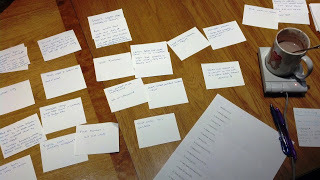 Then I discovered Shut Up & Write, a Meetup group for working writers of all sorts. It’s a very casual group, now with more than 25,000 members around the world, and totally free. I joined first in Sacramento, Calif. and started two morning groups there. Now I live in Boise, Idaho and launched the first Shut Up & Write there. We have well over a hundred members and have four writing sessions a week at various coffee shops. Writers sign up online to hold their spot for a session, show up and chat for a bit, and then write quietly on their own project for an hour. An hour doesn’t seem too long, but it’s amazing how joining others with the same creative energy spurs one forward.
Then I discovered Shut Up & Write, a Meetup group for working writers of all sorts. It’s a very casual group, now with more than 25,000 members around the world, and totally free. I joined first in Sacramento, Calif. and started two morning groups there. Now I live in Boise, Idaho and launched the first Shut Up & Write there. We have well over a hundred members and have four writing sessions a week at various coffee shops. Writers sign up online to hold their spot for a session, show up and chat for a bit, and then write quietly on their own project for an hour. An hour doesn’t seem too long, but it’s amazing how joining others with the same creative energy spurs one forward.My projects progress, but there’s also the benefit of friendships that develop and the mentoring I see happen. We share information about editing, plot development, writing conferences, and the long road to publishing. We also show each other pictures of our children and pets, offer suggestions on restaurants, and cheer each other on.
Writing doesn’t have to be a lonely business. If you don’t have a Shut Up & Write in your community, you may consider starting one. There’s information about the organization here.
Happy writing!
 Julie Howard is the author of the Wild Crime series. She is a former journalist and editor who has covered topics ranging from crime to cowboy poetry. She is a member of the Idaho Writers Guild and founder of the Boise chapter of Shut Up & Write. Learn more at juliemhoward.com.
Julie Howard is the author of the Wild Crime series. She is a former journalist and editor who has covered topics ranging from crime to cowboy poetry. She is a member of the Idaho Writers Guild and founder of the Boise chapter of Shut Up & Write. Learn more at juliemhoward.com.Crime Times Two (coming Fall 2018):
Meredith knows three things: First, the man in the library begged her to help him. Second, he was afraid of his wife. Third, now he’s dead.
While the evidence first points to a natural death, Meredith is certain there’s more to discover. People are tight-lipped in this small mountain village, and the man’s wife isn't talking either. Then a second death occurs, with remarkable similarities. It’s time to talk about murder.
As a slow-burning relationship heats up in her own life, Meredith struggles with concepts of love and hate, belief and suspicion, and absolution and guilt. Nothing is clear cut…
She must decide: Is guilt, like evil, something you can choose to believe in?
Excerpt:
Jowls quivered under the man’s weak chin, and Meredith noted the stained and frayed shirt of someone who spent a lot of time alone in dark rooms, sending out a better version of himself into the virtual world. His eyes were anxious and beseeching at her as though she should have a clear understanding of him and his life.
Somehow, over the past hour and a half they’d been sitting next to each other – him playing video games and sharing his life story and her ignoring him the best she could – she had become his confessor and friend.
Meredith gave him what she hoped was an impartial-though-quasi-friendly smile. She reached for her purse and papers and rose from her chair. “Well. Nice talking with you.”
The man was lost in his own train of thought and seemed only slightly aware that Meredith was leaving.
He shook his head, morose.
“To make a long story short,” he summed up, “I think my wife is trying to kill me.”
Visit Julie:WebsiteFacebookJulie's Amazon PageGet Julie's first novel, Crime and Paradise , in paperback or for the Kindle from Amazon.
Published on September 12, 2018 02:00
September 3, 2018
Is Your Villain Evil Enough? #Writing Advice from Chris Eboch
 (From the "Most Viewed" files...)
(From the "Most Viewed" files...)In previous posts, I've touched on using villains to add drama to your story. Let’s look at this more closely.
Use Your Villain
On the surface, this may sound obvious. The whole point of a villain is to make your hero’s life difficult, right? But I’ve found that it’s sometimes easy to forget about the villain when you’re focused on the hero’s actions. The villain sets something in motion and then disappears.
If you get stuck in your writing and can’t figure out what happens next, try checking in with your villain. Is he just sitting around, waiting for your hero to act? No! He should be actively trying to thwart your hero, plotting new complications and distractions. Realizing this can be the push you need to get past a slow spot.
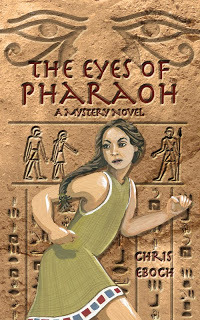 I found this helpful for my middle grade historical mystery,
The Eyes of Pharaoh
. The heroine, Seshta, had done everything she could to track down her missing friend. While hunting for him, she had tipped off the bad guy. When I realized that would mean the villain was actively plotting against her, I had the inspiration for several big action scenes leading to the dramatic climax.
I found this helpful for my middle grade historical mystery,
The Eyes of Pharaoh
. The heroine, Seshta, had done everything she could to track down her missing friend. While hunting for him, she had tipped off the bad guy. When I realized that would mean the villain was actively plotting against her, I had the inspiration for several big action scenes leading to the dramatic climax.Not every book has an actual villain, of course. But if you don’t have one, consider adding one. Even if it’s not necessary for the main plot, a villain could add drama as a subplot.
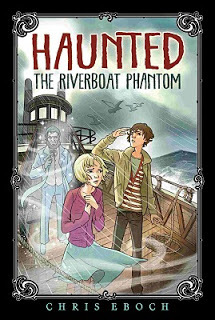 Example: In the Haunted series, each book’s main plot involves Jon and Tania trying to help the ghosts. In book one, I created a minor secondary character, a fake psychic who calls herself Madam Natasha. In The Riverboat Phantom, Madam Natasha figures out that Tania can see ghosts – something Tania desperately wants to keep secret. Madam Natasha uses the secret as a threat, as she demands that the kids share information about the ghosts and give her credit for helping them. In The Knight in the Shadows, the kids go to war with Madam Natasha, determined to expose her as a fraud. This is still secondary to trying to help the ghost, but it adds challenges and emotional drama.
Example: In the Haunted series, each book’s main plot involves Jon and Tania trying to help the ghosts. In book one, I created a minor secondary character, a fake psychic who calls herself Madam Natasha. In The Riverboat Phantom, Madam Natasha figures out that Tania can see ghosts – something Tania desperately wants to keep secret. Madam Natasha uses the secret as a threat, as she demands that the kids share information about the ghosts and give her credit for helping them. In The Knight in the Shadows, the kids go to war with Madam Natasha, determined to expose her as a fraud. This is still secondary to trying to help the ghost, but it adds challenges and emotional drama.Whether your villain is involved in the main plot or a subplot, he or she doesn’t have to be a diabolical evil genius. He can be a bully at school, a competitor on a sports team, a nasty boss, or even a manipulative sibling or friend. Whatever the “villain” is, his job is to make your hero’s life miserable.
Exercise: look over your work in progress. Do you have a major villain? If so, is the villain as active as possible, aggressively trying to stop, hurt, or kill your hero?
Do you have secondary characters with villainous tendencies? Can you enhance these, so they cause even more trouble?
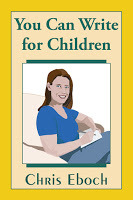 If you have no villain at all, brainstorm ways to add one.
If you have no villain at all, brainstorm ways to add one.Chris Eboch is the author of You Can Write for Children : A Guide to Writing Great Stories, Articles, and Books for Kids and Teenagers. Order for Kindle, in paperback, or in Large Print paperback. She is also the author of Advanced Plotting.
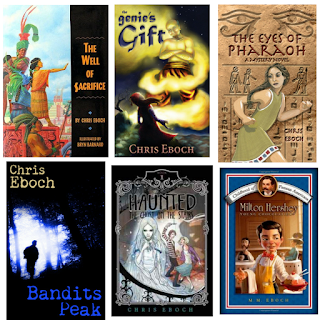 Chris has published over 50 books for children, including nonfiction and fiction, early reader through teen. Her novels for ages nine and up include The Eyes of Pharaoh, a mystery in ancient Egypt; The Well of Sacrifice, a Mayan adventure; The Genie’s Gift, a middle eastern fantasy; and the Haunted series, about kids who travel with a ghost hunter TV show, which starts with The Ghost on the Stairs. Her writing craft books include You Can Write for Children: How to Write Great Stories, Articles, and Books for Kids and Teenagers, and Advanced Plotting.
Chris has published over 50 books for children, including nonfiction and fiction, early reader through teen. Her novels for ages nine and up include The Eyes of Pharaoh, a mystery in ancient Egypt; The Well of Sacrifice, a Mayan adventure; The Genie’s Gift, a middle eastern fantasy; and the Haunted series, about kids who travel with a ghost hunter TV show, which starts with The Ghost on the Stairs. Her writing craft books include You Can Write for Children: How to Write Great Stories, Articles, and Books for Kids and Teenagers, and Advanced Plotting.Learn more at https://chriseboch.com/ or her Amazon page.
Published on September 03, 2018 02:00
August 27, 2018
Developing Your Novel: Putting Secondary Characters First - #Writing Advice
 (From the "Most Viewed" files...)
(From the "Most Viewed" files...)I've been talking about developing a story. Sometimes when planning a novel, we focus exclusively on the main character. But secondary characters are important for fleshing out the story world.
Every novel – and most short stories and picture books – will have secondary characters. In general, the longer the book, the more secondary characters you can fit. These can be family members, friends, teachers or bosses, aliens, mythical characters, or even pets. Some will be nice. Some will be annoying. Ideally, one or more should be trouble.
I’m not talking about villains here (I'll do that next week). But even well-meaning secondary characters can make your main character’s life more complicated. When writing for children, parents are a natural for this role. They may simply want what they see as best for their child – but if that is opposed to what the child wants, it adds complications. These could be strong enough to form the main plot, or could simply be additional challenges the child has to face.
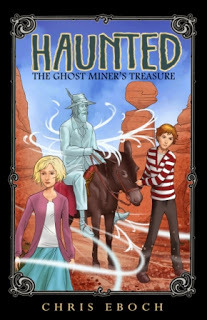 Example: In the Haunted series, Tania doesn’t want anyone to know that she can see ghosts. She’s afraid that her mother would want her to contact her dead little sister, and she doesn’t know how. Her stepfather would want to use her on his ghost hunter TV show, and people would think she was nuts. And her father doesn’t believe in ghosts, so he might think she was lying to get attention. Well-meaning family members with their own agendas make her desperate to keep her “gift” a secret.
Example: In the Haunted series, Tania doesn’t want anyone to know that she can see ghosts. She’s afraid that her mother would want her to contact her dead little sister, and she doesn’t know how. Her stepfather would want to use her on his ghost hunter TV show, and people would think she was nuts. And her father doesn’t believe in ghosts, so he might think she was lying to get attention. Well-meaning family members with their own agendas make her desperate to keep her “gift” a secret.Other examples of conflicting desires may be a dad who wants his son to play football, while the son wants to join the band, or parents who don’t want their daughter to date yet, when she’s fallen in love. A parent may be even a greater challenge, if he or she is an alcoholic, seriously ill, or depressed. Then, of course, there’s the issue of a divorced or widowed parent dating!
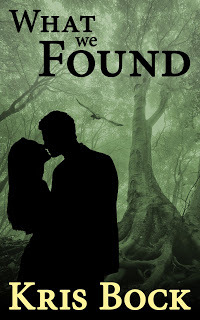 Even in adult novels, a parent may add pressure. In a romance, Mom may want the heroine to marry and provide grandchildren, nagging her to settle for the wrong man. Bosses can also add challenges, whether by pressuring the main character to do something illegal for the company or simply demanding long work hours which distract from other goals. In my romantic suspense novel What We Found (written as Kris Bock), the 22-year-old heroine has allies and enemies both at work and at home.
Even in adult novels, a parent may add pressure. In a romance, Mom may want the heroine to marry and provide grandchildren, nagging her to settle for the wrong man. Bosses can also add challenges, whether by pressuring the main character to do something illegal for the company or simply demanding long work hours which distract from other goals. In my romantic suspense novel What We Found (written as Kris Bock), the 22-year-old heroine has allies and enemies both at work and at home.Don’t forget friends, either! Friends can give bad advice, have their own agenda, use the main character for popularity or access to something or someone, or even secretly be trying to steal the main character’s love interest/job/position in society.
 That’s not to say all friends have to be sneaky betrayers. Even the best of friends might distract the main character with their own emotional problems. In the teen romantic comedy My Big Nose and Other Natural Disasters, by Sydney Salter, the heroine’s main goal is to save enough money from her summer job to get a nose job, so she can find a boyfriend. Her two best friends have their own problems with boys and jobs. In one scene, the main character is late to work, jeopardizing her job, because she’s been trying to protect a friend who had too much to drink.
That’s not to say all friends have to be sneaky betrayers. Even the best of friends might distract the main character with their own emotional problems. In the teen romantic comedy My Big Nose and Other Natural Disasters, by Sydney Salter, the heroine’s main goal is to save enough money from her summer job to get a nose job, so she can find a boyfriend. Her two best friends have their own problems with boys and jobs. In one scene, the main character is late to work, jeopardizing her job, because she’s been trying to protect a friend who had too much to drink.Exercise: go through your work in progress and list every secondary character who has a role beyond a few lines. Make a few notes on each one – what is their basic personality and role in the story? What do they want?
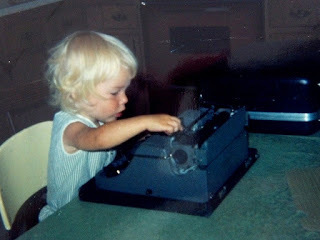 Then, for each secondary character, ask:
Then, for each secondary character, ask:• Could I develop this character more, to make him or her more complicated?• How could this secondary character be causing problems for my main character?• If the character is already causing problems, could they be even worse?
If you don’t have many secondary characters, consider adding some. What kind of character could add complications and drama? Make sure any new secondary characters fit smoothly into the plot, and don’t feel like they are just shoved in to cause trouble.
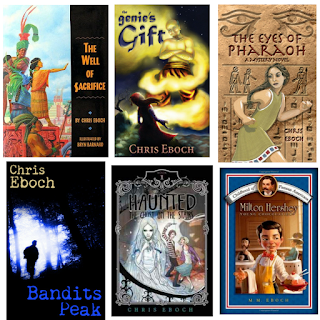 Chris Eboch is the author of
You Can Write for Children
: A Guide to Writing Great Stories, Articles, and Books for Kids and Teenagers. Order for Kindle, in paperback, or in Large Print paperback. She is also the author of Advanced Plotting.
Chris Eboch is the author of
You Can Write for Children
: A Guide to Writing Great Stories, Articles, and Books for Kids and Teenagers. Order for Kindle, in paperback, or in Large Print paperback. She is also the author of Advanced Plotting.Chris has published over 50 books for children, including nonfiction and fiction, early reader through teen. Her novels for ages nine and up include The Eyes of Pharaoh, a mystery in ancient Egypt; The Well of Sacrifice, a Mayan adventure; The Genie’s Gift, a middle eastern fantasy; and the Haunted series, about kids who travel with a ghost hunter TV show, which starts with The Ghost on the Stairs. Her writing craft books include You Can Write for Children: How to Write Great Stories, Articles, and Books for Kids and Teenagers, and Advanced Plotting.
Learn more at https://chriseboch.com/ or her Amazon page.
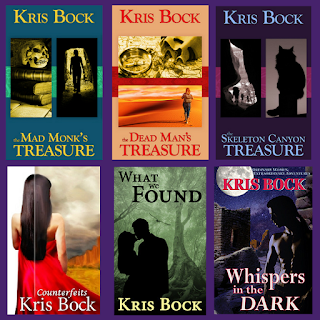
Chris also writes for adults under the name Kris Bock. Kris Bock writes action-packed romantic suspense involving outdoor adventures amidst Southwestern landscapes. The Mad Monk’s Treasure follows a treasure hunt in New Mexico. Whispers in the Dark involves intrigue among ancient Southwest ruins. Counterfeitsstarts a series about art theft. What We Found is a mystery with romantic elements about a young woman who finds a murder victim in the woods. Read excerpts at www.krisbock.comor visit her Amazon page.
Published on August 27, 2018 04:00
August 20, 2018
Research is a Must, No Matter the Genre - #Writing with @AmberDaulton1
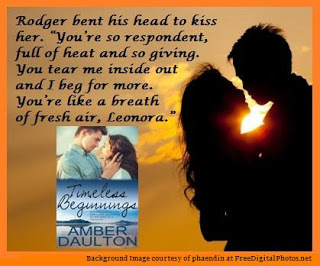 Welcome Amber Daulton, author of romantic suspense, paranormal, and historical romance novels, sharing her thoughts on research!
Welcome Amber Daulton, author of romantic suspense, paranormal, and historical romance novels, sharing her thoughts on research!No matter what genre an author writes, he or she must first research their chosen time-period or world. I’m a romance author and I love to write in a variety of subgenres, and all of them require in-depth research.
In my opinion, there’s no big difference in writing a novel set in the 1700s than writing one set in the modern era. Authors should research all the locations mentioned in the book to learn about the buildings, the common modes of transportation, the style of speech and mannerisms appropriate for the time and place, and the types of characters they wish to describe.
Even modern books need research like this. For instance, it doesn’t make much sense for a typical hardworking New Yorker to drive a car. Instead, the stressed-out secretary heroine will probably be catching the subway, but the author needs to know what line she’ll have to take, when that bus will arrive in the business district, and how many blocks she has to walk to reach the office. Little details like that might seem like overkill, but you never know what you’ll need until you’re writing the scene. Besides, details always add more depth to the story, but you also need to find a healthy medium to not drown the story and your reader in them.
Research can also lead your novel in a direction you didn’t see or plan. You might realize you need to add new scenes and characters, or kill off a character. For historical novels, you need to check on the etymology of words. For example, you shouldn’t write the word “vampire” in a book set in the 1600s because the word wasn’t coined until the 1700s.
 Also, details and facts shouldn’t just be dropped into the story without a good transition or reason. The information should be weaved into the description and dialogue without bogging down the scene. If necessary, spread the details out throughout various scenes and chapters. Don’t tell the reader everything at once. Let them stew over the details for a little while and then give them more later on.
Also, details and facts shouldn’t just be dropped into the story without a good transition or reason. The information should be weaved into the description and dialogue without bogging down the scene. If necessary, spread the details out throughout various scenes and chapters. Don’t tell the reader everything at once. Let them stew over the details for a little while and then give them more later on. Not every author can do hands-on research and travel all over the world to study locations and cultures. Most of them rely on books, the Internet, or the opinions of friends and colleagues who have traveled to those areas.
I always try to have my research done before I start writing, but sometimes that’s just not possible. When the WIP goes in a direction I didn’t expect, I have to power up the Internet or pull out my textbooks to double check answers and to look for something fresh to help the book’s new flow.
No matter how much research you do, it’s almost impossible to know everything about your chosen subject, but you should at least be able to write a convincing story. For me, research can be more fun than writing. It’s a constant reminder that things always change. Nothing is set in stone, and an author needs to be flexible when plotting and writing the book.
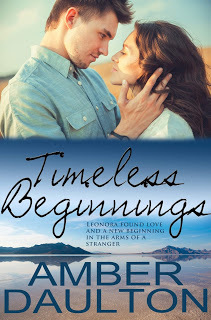 Timeless Beginnings
Contemporary/Time Travel Romance Word Count: 30k Heat Level: 3 Flames
Timeless Beginnings
Contemporary/Time Travel Romance Word Count: 30k Heat Level: 3 Flames Leonora Harris fled her newly wedded husband’s home in Georgian England, 1725, and took shelter in a cave during a rainstorm. She woke up in a cold, barren land and a handsome stranger with a mechanical carriage offered her shelter.
Undercover American operative Rodger Ramsey never expected to find a runaway bride in the magnificent Salar de Uyuni. Assigned to Bolivia to investigate Communist activities, he just wrapped up his two-year mission in 1963 and followed his heart to the salt flats one last time.Sparks flew and attraction sizzled. The lost, stubborn woman kicked his protective instincts into overdrive. Rodger took her home with him, determined to help her before he returned to the States, and Leonora flourished under his guidance. Their hearts intertwined. He wanted her, needed her, but could he truly love a woman who believed she jumped two hundred years in time?
Will they find a way to stay together, despite the obstacles between them, or will Leonora survive in this strange new world alone?
(Author’s Note - This is a prequel to Timeless Honor, a time travel romance with Rodger and Leonora’s granddaughter, but can be read as a standalone.)
Excerpt
“I’ll do or say whatever you wish, illegal or not.” Leonora steeled her spine as the words tore up her throat. “I thought you trusted me. What can I do to earn it?”
Rodger ate up the distance between them with three long strides and shackled her wrist in his large hand like a manacle. She stumbled toward him. Tension permeated the air around him in waves of red-hot heat.
“Have you heard of the CIA, Leonora? The Central Intelligence Agency?”
“No, I have no idea what that is.”
“What can you tell me about the communist activities and alliances in this country?”
“Nothing. I don’t know. What kind of questions are these? What are you talking about?”
His head tilted to one side and his lips thinned. Rodger stared at her with a long, hard gaze even as she squirmed, the steel in her spine gone. Stress lined his face and the tendon in his neck throbbed against his skin like a tic. Minutes passed, or maybe just seconds, and air whizzed out through his nostrils. The anger in his face seemed to drain and he somehow looked older.
“How can this be? You told me the truth about everything.” He stepped back and stroked his fingers up her arm. “Though you squirmed under my gaze, you did so after you answered me and only because I intimidated you. You didn’t once respond with a typical facial or verbal nuance to indicate you lied. I feel the truth of your words in my gut and in my soul.”
“I haven’t once lied to you.”
“I just—I don’t understand. This is so unbelievable. I wish you could provide me with some kind of undeniable proof you’re from the past.”
“As do I, Rodger.”
Buy Timeless Beginnings Amazon - http://amzn.to/2auj8SsBooks2Read - https://books2read.com/u/meAAnE
See Timeless Beginnings on Goodreads – https://www.goodreads.com/book/show/30638898-timeless-beginnings
 Writing is the fruit of happiness.
Writing is the fruit of happiness.Amber Daultonlives her life by that one belief even though she normally isn’t so Zen.
As a fan of contemporary, paranormal, and historical romance novels alike, she can’t get enough of feisty heroines and alpha heroes. Her mind is a wonderland of adventure, laughter, and awesome ways of kicking a guy when he’s down. She probably wouldn’t be too sane without her computer and notebooks. After all, what’s a girl to do when people are jabbering away in her head and it’s hard to shut them up? Write! Nothing else works.
Stalk Me Blogsite – http://amberdaultonauthor.blogspot.com/Facebook Author Page – www.facebook.com/amber.daulton.authorTwitter – https://twitter.com/AmberDaulton1Pinterest – http://pinterest.com/amberdaulton5/ Goodreads – www.goodreads.com/author/show/6624921.Amber_DaultonAmazon Author Page – http://amzn.to/14JoZffInstagram - https://www.instagram.com/amberdaultonauthor/Book Bub – https://www.bookbub.com/profile/amber-daultonSmashwords – https://www.smashwords.com/profile/view/amberdaultonLinkedIn – www.linkedin.com/pub/amber-daulton/87/538/368 Google Plus - https://plus.google.com/u/0/+AmberDaulton Books to Go Now – http://bookstogonow.com/tb-author/amber-daulton/
Published on August 20, 2018 02:00
August 18, 2018
Plot/Character Exercises - #Writing Advice from Chris Eboch
 (From the "Most Viewed" files...)
(From the "Most Viewed" files...)We've been talking about how conflict comes from the interaction between character and plot. Let's look more closely at character.
Six basic human needs influence character:
Growth (working toward a personal goal)
Contribution (feeling needed, worthwhile)
Security (knowing the future)
Change (desire for variety, excitement)
Connection (feeling part of a group)
Independence (personal identity and freedom)
Which of these are most important to your main character? Create conflict by setting up situations which oppose that person’s needs.
 Who are the best characters
Who are the best charactersfor ghost hunting?Exercise—Write a story, starting with plot.
Come up with a challenge – a difficult situation for someone. This can be anything from facing the first day of school to wanting to make a sports team to solving a crime to fighting zombies.
Then ask, What kind of person would have the most trouble in that situation? Plan or write a story about that character in that situation.
Exercise—Write a story, starting with character.
Write a brief character sketch, covering basics such as gender, age, personality characteristics – introvert/ extrovert, optimist/ pessimist, etc. – with a few likes and dislikes. You can base this on someone you know.
How would they define or describe themselves? (“I always…I never…I’m the kind of person who….”)
 What happens when a shy,
What happens when a shy,sheltered girl goes on a quest?• If these statements are true, a situation that challenges the belief will create conflict. For example, if you have a character who is honest, put him in a situation where there is a good reason to lie.
• If these statements are false, a situation that exposes the delusion will create conflict. For example, if someone sees himself as courageous, but isn't really, a situation that requires courage will be especially painful because it shakes up his view of himself.
So, what situation will most challenge this character? Summarize or write a story about that character in that situation.
You know you need both an interesting character and a strong plot to make a good story. As you develop an idea, think about how your character and plot interact, and design your character for your plot. As you write the story, work back and forth between plot and character.
 One more exercise:
One more exercise:Look at your work in progress. What is the problem? Why is it important? Why is it difficult? (See the post From Idea to Story Part 2: Setting up Conflict.)
Given those answers, is your character the right character for that situation? Could you give your character different needs or desires, to make the situation more difficult for him or her?
 Chris Eboch is the author of
You Can Write for Children
: A Guide to Writing Great Stories, Articles, and Books for Kids and Teenagers. Order for Kindle, in paperback, or in Large Print paperback. She is also the author of Advanced Plotting.
Chris Eboch is the author of
You Can Write for Children
: A Guide to Writing Great Stories, Articles, and Books for Kids and Teenagers. Order for Kindle, in paperback, or in Large Print paperback. She is also the author of Advanced Plotting.Chris has published over 50 books for children, including nonfiction and fiction, early reader through teen. Her novels for ages nine and up include The Eyes of Pharaoh, a mystery in ancient Egypt; The Well of Sacrifice, a Mayan adventure; The Genie’s Gift, a middle eastern fantasy; and the Haunted series, about kids who travel with a ghost hunter TV show, which starts with The Ghost on the Stairs. Her writing craft books include You Can Write for Children: How to Write Great Stories, Articles, and Books for Kids and Teenagers, and Advanced Plotting.
Learn more at https://chriseboch.com/ or her Amazon page.
 Chris also writes for adults under the name Kris Bock. Kris Bock writes action-packed romantic suspense involving outdoor adventures amidst Southwestern landscapes. The Mad Monk’s Treasure follows a treasure hunt in New Mexico. Whispers in the Dark involves intrigue among ancient Southwest ruins. Counterfeitsstarts a series about art theft. What We Found is a mystery with romantic elements about a young woman who finds a murder victim in the woods. Read excerpts at www.krisbock.comor visit her Amazon page.
Chris also writes for adults under the name Kris Bock. Kris Bock writes action-packed romantic suspense involving outdoor adventures amidst Southwestern landscapes. The Mad Monk’s Treasure follows a treasure hunt in New Mexico. Whispers in the Dark involves intrigue among ancient Southwest ruins. Counterfeitsstarts a series about art theft. What We Found is a mystery with romantic elements about a young woman who finds a murder victim in the woods. Read excerpts at www.krisbock.comor visit her Amazon page.
Published on August 18, 2018 04:00
August 13, 2018
Be Cruel to Your Characters - #Writing a Strong Plot, by Chris Eboch
 For a strong plot, you need plenty of dramatic action. (This doesn't necessarily mean fights and car chases. The drama can come from interpersonal relationships or even a person's own thoughts. But dramatic things should happen.) But it's not enough just to have dramatic things happening. It's not just What but also Who.
For a strong plot, you need plenty of dramatic action. (This doesn't necessarily mean fights and car chases. The drama can come from interpersonal relationships or even a person's own thoughts. But dramatic things should happen.) But it's not enough just to have dramatic things happening. It's not just What but also Who.Your main character needs to be able to overcome the challenge you set for him – but just barely. We don't want to watch superheroes fight weaklings. We want to watch superheroes fight supervillains – or even better, weaklings fight supervillains, and barely win, through courage and ingenuity that overcome the stronger foe.
Conflict comes from the interaction between character and plot. You can create conflict by setting up situations which force a person to confront their fears. If someone is afraid of heights, make them go someplace high. If they're afraid of taking responsibility, force them to be in charge.
You can also create conflict by setting up situations which oppose a person’s desires. If they crave safety, put them in danger. But if they crave danger, keep them out of it.
 In The Well of Sacrifice, Eveningstar never dreams of being a leader or a rebel. But when her family, the government, and even the gods fail to stop the evil high priest, she's forced to act. In the Haunted series, Jon would like to be an ordinary kid and stay out of trouble. But his sister is determined to help ghosts without letting the grown-ups know what she and Jon are doing, and is constantly getting him into trouble. The reluctant hero is a staple of books and movies because it's fun to watch someone forced into a heroic role when they don't want it. (Think of Harrison Ford as Han Solo.)
In The Well of Sacrifice, Eveningstar never dreams of being a leader or a rebel. But when her family, the government, and even the gods fail to stop the evil high priest, she's forced to act. In the Haunted series, Jon would like to be an ordinary kid and stay out of trouble. But his sister is determined to help ghosts without letting the grown-ups know what she and Jon are doing, and is constantly getting him into trouble. The reluctant hero is a staple of books and movies because it's fun to watch someone forced into a heroic role when they don't want it. (Think of Harrison Ford as Han Solo.) Even with nonfiction, you can create tension by focusing on the challenges that make a person's accomplishments more impressive. In my book Jesse Owens: Young Record Breaker, written under the name M.M. Eboch, I made this incredible athlete’s story more powerful by focusing on all the things he had to overcome – childhood health problems, poverty, a poor education. In Milton Hershey: Young Chocolatier (also written as M.M. Eboch) the story of the man who founded Hershey's chocolate is more dramatic because he started with little business experience, and had an unfortunate habit of trusting his overzealous father.
Even with nonfiction, you can create tension by focusing on the challenges that make a person's accomplishments more impressive. In my book Jesse Owens: Young Record Breaker, written under the name M.M. Eboch, I made this incredible athlete’s story more powerful by focusing on all the things he had to overcome – childhood health problems, poverty, a poor education. In Milton Hershey: Young Chocolatier (also written as M.M. Eboch) the story of the man who founded Hershey's chocolate is more dramatic because he started with little business experience, and had an unfortunate habit of trusting his overzealous father.Exercise: Ask yourself these questions. They may lead to new story ideas, or you can use them to further develop characters in your current work.
 What are you afraid of?
What are you afraid of?What's the hardest thing you have had to do or overcome?
What's the hardest thing you've done by choice?
Ask other people the same questions, for more ideas.
 Chris Eboch is the author of
You Can Write for Children
: A Guide to Writing Great Stories, Articles, and Books for Kids and Teenagers. Order for Kindle, in paperback, or in Large Print paperback. She is also the author of Advanced Plotting.
Chris Eboch is the author of
You Can Write for Children
: A Guide to Writing Great Stories, Articles, and Books for Kids and Teenagers. Order for Kindle, in paperback, or in Large Print paperback. She is also the author of Advanced Plotting.Chris has published over 50 books for children, including nonfiction and fiction, early reader through teen. Her novels for ages nine and up include The Eyes of Pharaoh, a mystery in ancient Egypt; The Well of Sacrifice, a Mayan adventure; The Genie’s Gift, a middle eastern fantasy; and the Haunted series, about kids who travel with a ghost hunter TV show, which starts with The Ghost on the Stairs. Her writing craft books include You Can Write for Children: How to Write Great Stories, Articles, and Books for Kids and Teenagers, and Advanced Plotting.
Learn more at https://chriseboch.com/ or her Amazon page.
 Chris also writes for adults under the name Kris Bock. Kris Bock books are action-packed romantic suspense involving outdoor adventures amidst Southwestern landscapes. The Mad Monk’s Treasure follows a treasure hunt in New Mexico. Whispers in the Dark involves intrigue among ancient Southwest ruins. Counterfeitsstarts a series about art theft. What We Found is a mystery with romantic elements about a young woman who finds a murder victim in the woods. Read excerpts at www.krisbock.comor visit her Amazon page.
Chris also writes for adults under the name Kris Bock. Kris Bock books are action-packed romantic suspense involving outdoor adventures amidst Southwestern landscapes. The Mad Monk’s Treasure follows a treasure hunt in New Mexico. Whispers in the Dark involves intrigue among ancient Southwest ruins. Counterfeitsstarts a series about art theft. What We Found is a mystery with romantic elements about a young woman who finds a murder victim in the woods. Read excerpts at www.krisbock.comor visit her Amazon page.
Published on August 13, 2018 04:00
August 6, 2018
Writing Tight: Don't Be Wordy - #Writing Advice from Chris Eboch
 (From the "Most Viewed" files...)
(From the "Most Viewed" files...)I do a lot of manuscript critiques. (See my rates andrecommendations.) Even advanced writers often get wordy. Here are some tips on eliminating that problem so your writing is as tight as my current deadlines are (plus other sources with more detail).
One of my pet peeves is characters nodding their heads or shrugging their shoulders. What else would one nod or shrug? We don't nod our elbows or shrug our stomachs. (If you have a character doing that, then definitely specify!) Otherwise, you can simply say he noddedor she shrugged. Yes, I know, this is a tiny, unimportant detail. But trust me, once it's pointed out to you, you'll start to notice and find it irritating!
Another unnecessary phrase – he thought to himself. Unless you have psychic characters, we'll assume he's not thinking to someone else. (In close point of view, you don't need to use "he thought" at all; just state the thought and we'll understand that the character is thinking it. But that's another issue.)
If you have more web browsing time, here are a couple of my favorite posts on eliminating wordiness.
Cut the Clutter and Streamline Your Writing, from Crime Fiction Collective, by Jodie Renner Editing: “Once you’ve gotten through your first draft, it’s important to go back in and cut down on wordiness and redundancies in order to make your story more compelling, pick up the pace, and increase the tension and sense of urgency.”
Cut the Clutter and Streamline Your Writing, Part II, from Crime Fiction Collective by Jodie Renner Editing: “Start by cutting out qualifiers like very, quite, rather, somewhat, kind of, and sort of, which just dilute your message, weaken the imagery, and dissipate the tension.”
It’s a Story, Not an Instruction Manual!, from Crime Fiction Collective, by Jodie Renner Editing: “Whether you’re writing an action scene or a love scene, it’s best not to get too technical or clinical about which hand or leg or finger or foot is doing what, unless it’s relevant or necessary for understanding.”
And a warning not to take things too far:
Crossing Words Off Your List: Making the Most of Editing "What Not to Use" Lists, from The Other Side of the Story by Janice Hardy: “The right word for what you're trying to say is always the right choice, no matter what that word is. Most times, cutting that flabby word or finding that strong noun or active verb is the right choice, but once in a while it's not.”
 Chris Eboch is the author of over 50 books for children, including nonfiction and fiction, early reader through teen. Her novels for ages nine and up include The Eyes of Pharaoh, a mystery in ancient Egypt; The Well of Sacrifice, a Mayan adventure; The Genie’s Gift, a middle eastern fantasy; and the Haunted series, about kids who travel with a ghost hunter TV show, which starts with The Ghost on the Stairs. Her writing craft books include You Can Write for Children: How to Write Great Stories, Articles, and Books for Kids and Teenagers, and Advanced Plotting.
Chris Eboch is the author of over 50 books for children, including nonfiction and fiction, early reader through teen. Her novels for ages nine and up include The Eyes of Pharaoh, a mystery in ancient Egypt; The Well of Sacrifice, a Mayan adventure; The Genie’s Gift, a middle eastern fantasy; and the Haunted series, about kids who travel with a ghost hunter TV show, which starts with The Ghost on the Stairs. Her writing craft books include You Can Write for Children: How to Write Great Stories, Articles, and Books for Kids and Teenagers, and Advanced Plotting. Learn more at https://chriseboch.com/or her Amazon page, or check out her writing tips at her Write Like a Pro! blog.
Published on August 06, 2018 03:30



